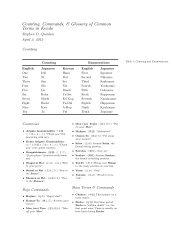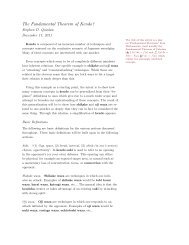Kendo no Kata and Their Effects on Kendo - The Kingston Kendo Club
Kendo no Kata and Their Effects on Kendo - The Kingston Kendo Club
Kendo no Kata and Their Effects on Kendo - The Kingston Kendo Club
Create successful ePaper yourself
Turn your PDF publications into a flip-book with our unique Google optimized e-Paper software.
<str<strong>on</strong>g>Kendo</str<strong>on</strong>g> <str<strong>on</strong>g>no</str<strong>on</strong>g> <str<strong>on</strong>g>Kata</str<strong>on</strong>g> <str<strong>on</strong>g>and</str<strong>on</strong>g> <str<strong>on</strong>g><strong>The</strong>ir</str<strong>on</strong>g> <str<strong>on</strong>g>Effects</str<strong>on</strong>g> <strong>on</strong> <str<strong>on</strong>g>Kendo</str<strong>on</strong>g><br />
Sensei Morito Tsumura, <str<strong>on</strong>g>Kendo</str<strong>on</strong>g> 8 th Dan, Kyoshi<br />
June 26, 2011<br />
<strong>The</strong> following article was prepared for a nih<strong>on</strong> kendo <str<strong>on</strong>g>no</str<strong>on</strong>g> kata & kih<strong>on</strong> bokuto waza seminar<br />
<strong>on</strong> June 10 th & 11 th , 2011 hosted by the Ottawa <str<strong>on</strong>g>and</str<strong>on</strong>g> Shoshin <str<strong>on</strong>g>Kendo</str<strong>on</strong>g> <strong>Club</strong>s. <strong>The</strong> format of the<br />
article, <str<strong>on</strong>g>no</str<strong>on</strong>g>tes & definiti<strong>on</strong>s have been altered from the original style.<br />
Although it is a comm<strong>on</strong> tendancy to set our goal in winning kendo<br />
matches, developing mental c<strong>on</strong>trol is much more important. <strong>The</strong><br />
best way, <str<strong>on</strong>g>and</str<strong>on</strong>g> absolutely essential, to accomplish this is to practice<br />
kendo <str<strong>on</strong>g>no</str<strong>on</strong>g> kata which in turn will produce kihaku 1 ,ë. Afterall,<br />
however skillful, kendo <str<strong>on</strong>g>no</str<strong>on</strong>g> kata without kihaku is <str<strong>on</strong>g>no</str<strong>on</strong>g>thing more<br />
than a dance with a sword.<br />
<strong>The</strong>refore practicing kendo <str<strong>on</strong>g>no</str<strong>on</strong>g> kata with kihaku will produce<br />
improvement in the following aspects related to kendo:<br />
1<br />
Kihaku: <strong>on</strong>e’s mental/spiritual<br />
strength.<br />
1. Calmness <str<strong>on</strong>g>and</str<strong>on</strong>g> good c<strong>on</strong>duct<br />
2. Fine posture<br />
3. Sensing opp<strong>on</strong>ent’s movements <str<strong>on</strong>g>and</str<strong>on</strong>g> intenti<strong>on</strong>s<br />
4. Agility in movements<br />
5. Eliminating bad habits<br />
6. Reading of right maai 2 . 2<br />
Maai: distance from the opp<strong>on</strong>ent.<br />
7. Increasing kiai <str<strong>on</strong>g>and</str<strong>on</strong>g> kihaku<br />
8. Deeper underst<str<strong>on</strong>g>and</str<strong>on</strong>g>ing of kendo <str<strong>on</strong>g>and</str<strong>on</strong>g> its meaning<br />
9. Fine character with dignity <str<strong>on</strong>g>and</str<strong>on</strong>g> elegance<br />
Basic <str<strong>on</strong>g>Kendo</str<strong>on</strong>g> Practice with Bokuto<br />
( kˆ‹cSú,=äÕ<br />
Through the basic kendo practice with bokuto 3 , <strong>on</strong>e must always<br />
regard the bokuto as if it is a real sword 4 . With such underst<str<strong>on</strong>g>and</str<strong>on</strong>g>ing<br />
of a sword, we learn the basic technique of shinai kendo through<br />
practice with bokuto.<br />
Using bokuto will also enable us to underst<str<strong>on</strong>g>and</str<strong>on</strong>g> <str<strong>on</strong>g>and</str<strong>on</strong>g> learn how<br />
the sword is used in such waza 5 as harai, nuki, suriage, kaeshi, <str<strong>on</strong>g>and</str<strong>on</strong>g><br />
kiriotoshi, which in turn will utilize improvement of kendo <str<strong>on</strong>g>no</str<strong>on</strong>g> kata.<br />
3<br />
Bokuto: wooden sword.<br />
4<br />
Underst<str<strong>on</strong>g>and</str<strong>on</strong>g>ing that the Japanese<br />
sword has a particular shape each part<br />
of which having a distinct functi<strong>on</strong>.<br />
5<br />
Waza: technique.<br />
Points to Observe in Practicing <str<strong>on</strong>g>Kendo</str<strong>on</strong>g> <str<strong>on</strong>g>no</str<strong>on</strong>g> <str<strong>on</strong>g>Kata</str<strong>on</strong>g><br />
While we observe certain set form <str<strong>on</strong>g>and</str<strong>on</strong>g> order when practicing kendo<br />
<str<strong>on</strong>g>no</str<strong>on</strong>g> kata, it is important to be always serious <str<strong>on</strong>g>and</str<strong>on</strong>g> apply kihaku.
kendo <str<strong>on</strong>g>no</str<strong>on</strong>g> kata <str<strong>on</strong>g>and</str<strong>on</strong>g> their effects <strong>on</strong> kendo 2<br />
Uchidachi 6 , who makes the move at the most opportune moment<br />
of full kihaku, always initiates the attack up<strong>on</strong> which shidachi must<br />
counterattack in resp<strong>on</strong>se.<br />
Despite the defensive appearance of his attack, shidachi must<br />
attack with the vigor <str<strong>on</strong>g>and</str<strong>on</strong>g> active spirit of an offensive attacker.<br />
While uchidachi teaches from the positi<strong>on</strong> of a master, shidachi<br />
must learn the skill for victory.<br />
Excellent form (kata) result <strong>on</strong>ly when perfect balance between<br />
practical skills, masterly techniques, <str<strong>on</strong>g>and</str<strong>on</strong>g> flexible movements is<br />
achieved.<br />
6<br />
Uchidachi: initiating attacker.<br />
When Practicing, Observe the Following Basic Rules<br />
1. Always keep your eyes <strong>on</strong> the opp<strong>on</strong>ent’s eyes.<br />
2. Use suriashi 7 both in moving forward from the fr<strong>on</strong>t foot <str<strong>on</strong>g>and</str<strong>on</strong>g> 7<br />
Suriashi: footwork where feet brush<br />
backward from the back foot.<br />
the floor.<br />
3. Use large movements of the sword when attacking, drawing an<br />
arc with the point of the sword.<br />
4. In attack, draw your back foot close to the fr<strong>on</strong>t foot, relax your<br />
shoulders, gather force in your lower abdomen, <str<strong>on</strong>g>and</str<strong>on</strong>g> step forward<br />
from your waist.<br />
5. Kakegoe 8 should come from the t<str<strong>on</strong>g>and</str<strong>on</strong>g>en 9 forcibly: “Yaaah!” for 8<br />
Kakegoe: shouting.<br />
uchidachi, “Toooh!” for shidachi.<br />
9<br />
T<str<strong>on</strong>g>and</str<strong>on</strong>g>en: lower abdomen.<br />
6. Hold your breath when moving forward or backward in order to<br />
maximize inner power. Breathe abdominally when entering a maai<br />
so that the opp<strong>on</strong>ent will <str<strong>on</strong>g>no</str<strong>on</strong>g>t detect your move.<br />
7. In kata forms with the l<strong>on</strong>g sword (<str<strong>on</strong>g>no</str<strong>on</strong>g>. 1 to <str<strong>on</strong>g>no</str<strong>on</strong>g>. 7) “ki wo mite” 10 10 Ki wo mite: seizing the moment.<br />
while in kata forms with the short sword (<str<strong>on</strong>g>no</str<strong>on</strong>g>. 8 to <str<strong>on</strong>g>no</str<strong>on</strong>g>. 10) “irimi ni<br />
narouto suru” 11 are the emphasis.<br />
11<br />
Irimi ni narouto suru: taking overpowering<br />
approach.














